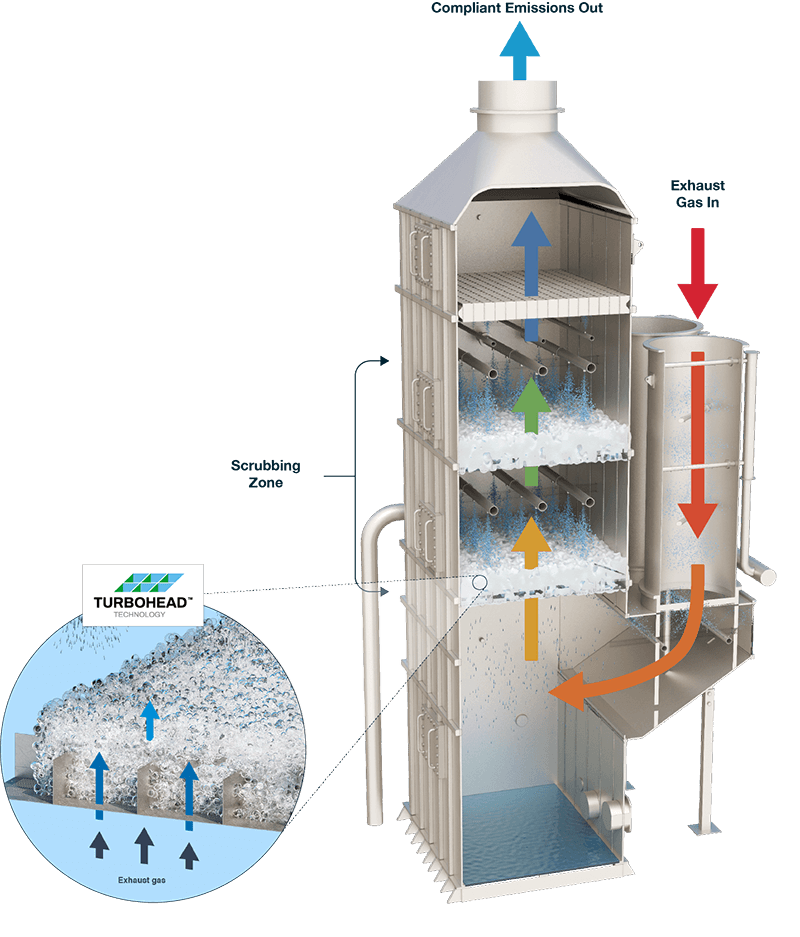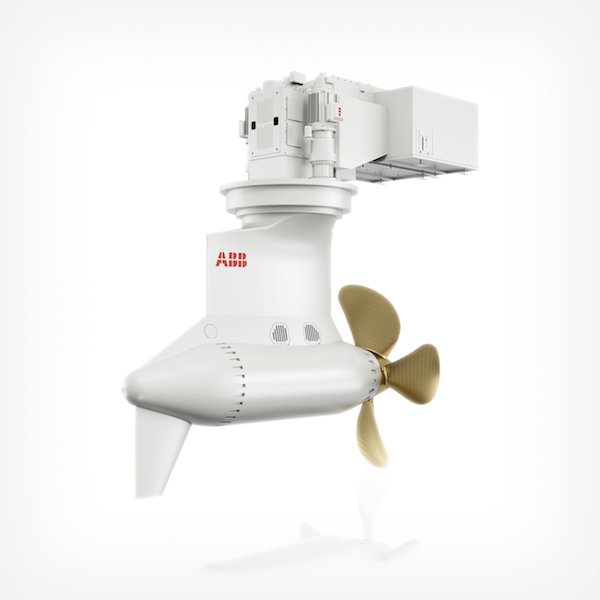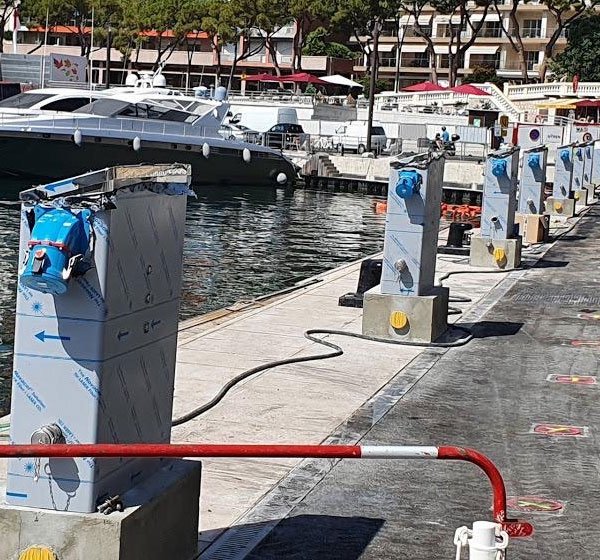
Contents
- Introduction
- Types of Maritime Exhaust Gas Scrubbers
- Open Loop Scrubbers
- Closed Loop Scrubbers
- Hybrid Scrubbers
- Components of a Scrubber System
- How Scrubbers Work
- Popular Models of Scrubbers
- Open Loop: Wärtsilä Open Loop Scrubber
- Closed Loop: Alfa Laval PureSOx Closed Loop
- Hybrid: Yara Marine SOx Scrubber Hybrid
- Conclusion
- References
1. Introduction
Maritime exhaust gas scrubbers are essential systems installed on ships to reduce sulphur oxide (SOx) emissions from the combustion of marine fuels. These systems help vessels comply with international environmental regulations, improving air quality and minimizing the environmental impact of shipping operations. There are three main types of scrubbers: open loop, closed loop, and hybrid scrubbers. Each type has distinct operational mechanisms and advantages.
2. Types of Maritime Exhaust Gas Scrubbers
Open Loop Scrubbers
Open loop scrubbers use seawater to neutralize and remove sulphur oxides from exhaust gases. Here’s how they operate:
- Mechanism: Seawater is pumped into the scrubber, where it reacts with the sulphur oxides in the exhaust gases to form sulfuric acid. The natural alkalinity of seawater neutralizes the acid, and the treated water is then discharged back into the sea.
- Advantages: Lower installation and operational costs, simplicity, and the natural availability of seawater.
- Disadvantages: Discharge of treated water back into the sea can be problematic in ports or sensitive areas with strict discharge regulations.
Closed Loop Scrubbers
Closed loop scrubbers use a closed system with freshwater mixed with an alkaline substance (usually sodium hydroxide) to neutralize sulphur oxides. Here’s how they work:
- Mechanism: Freshwater, mixed with an alkaline solution, circulates in the scrubber to remove sulphur oxides from the exhaust gases. The water is then cleaned and recirculated within the system, and the resulting waste is collected and discharged at port.
- Advantages: No discharge into the sea, making it suitable for use in ports and environmentally sensitive areas.
- Disadvantages: Higher operational costs due to the need for chemicals and more complex system maintenance.
Hybrid Scrubbers
Hybrid scrubbers combine the functionalities of both open loop and closed loop systems, offering operational flexibility based on environmental conditions and regulations. Here’s how they function:
- Mechanism: Hybrid scrubbers can switch between open loop and closed loop modes. In open loop mode, they use seawater directly. In closed loop mode, they use a recirculated freshwater system with added alkaline.
- Advantages: Flexibility to operate in different environmental conditions and compliance with diverse regulations.
- Disadvantages: Higher installation and maintenance costs due to the complexity of combining both systems.
3. Components of a Scrubber System
A typical scrubber system comprises several key components:
- Scrubber Unit: The main chamber where exhaust gas cleaning occurs.
- Pumps: To circulate seawater or freshwater through the scrubber.
- Mixing/Reaction Tank: For closed loop systems, where the alkaline solution is mixed with water.
- Monitoring and Control System: Ensures the scrubber operates within specified parameters and complies with emission regulations.
- Wash Water Treatment System: For treating and managing the discharge water, particularly in closed loop systems.
- Sensors and Probes: To monitor the levels of SOx, pH, and other parameters.
4. How Scrubbers Work
The operation of a scrubber system involves the following steps:
- Intake of Exhaust Gases: Exhaust gases from the engine are directed into the scrubber unit.
- Spraying of Water/Alkaline Solution: In open loop systems, seawater is sprayed into the scrubber. In closed loop systems, a mixture of freshwater and an alkaline solution is used.
- Chemical Reaction: The sulphur oxides in the exhaust gases react with the water or alkaline solution, forming a neutralized compound (sulfuric acid in the case of seawater, or neutral salts in the case of alkaline solutions).
- Separation and Treatment: The treated exhaust gases are released into the atmosphere, while the wash water is either discharged into the sea (in open loop systems) or treated and reused (in closed loop systems).
- Monitoring and Control: The system continuously monitors emissions and operational parameters to ensure compliance with regulations.
5. Popular Models of Scrubbers
Open Loop: Wärtsilä Open Loop Scrubber
- Model: Wärtsilä Open Loop Scrubber
- Features: Utilizes seawater for scrubbing SOx from exhaust gases, designed for simplicity and cost-efficiency.
- Applications: Ideal for vessels operating primarily in open seas with less stringent discharge regulations.
- Cost: Approximately $2 million to $4 million, depending on vessel size and installation complexity.
Closed Loop: Alfa Laval PureSOx Closed Loop
- Model: Alfa Laval PureSOx Closed Loop
- Features: Uses freshwater mixed with an alkaline solution, suitable for operation in ECAs and ports with strict discharge regulations.
- Applications: Vessels requiring compliance with strict environmental regulations in various regions.
- Cost: Approximately $3 million to $6 million, depending on system size and vessel requirements.
Hybrid: Yara Marine SOx Scrubber Hybrid
- Model: Yara Marine SOx Scrubber Hybrid
- Features: Combines open loop and closed loop functionalities, offering flexibility to switch modes based on operational needs.
- Applications: Vessels operating in diverse environmental conditions and regions.
- Cost: Approximately $4 million to $8 million, depending on configuration and vessel size.
6. Conclusion
Maritime exhaust gas scrubbers are vital for reducing SOx emissions and meeting environmental regulations. Open loop, closed loop, and hybrid scrubbers each offer unique advantages and challenges, allowing ship operators to choose the best system based on their operational needs and regulatory requirements. Popular models from manufacturers like Wärtsilä, Alfa Laval, and Yara Marine Technologies provide robust solutions for various applications.
For a more detailed discussion on the environmental impacts of ship scrubbers, including their contribution to water pollution, visit Inside Climate News.
7. References
- International Maritime Organization (IMO) MARPOL Annex VI
- European Union Sulphur Directive
- Industry reports and technical guidelines from Wärtsilä, Alfa Laval, and Yara Marine Technologies




